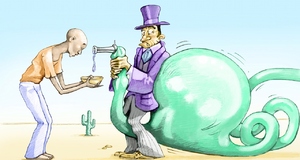Superbrands, Globalization, and Neoliberalism: Exploring Causes and Consequences of the Nike Superbrand
By
2011, Vol. 3 No. 12 | pg. 2/2 | « Second, concerning the race to the bottom, as the markets become more integrated and global, and restrictions on transnational flow of goods and services are quickly being eliminated, the result on wages, working conditions, employment and social security are devastating. According to Brecher and Costello (1998), the most direct result of globalization is “the ‘race to the bottom’ itself – the reduction in labor, social, and environmental conditions that results directly from global competition for jobs and investment” (p22). This race to the bottom is predominantly a vehicle for the MNCs, is sometimes promoted by governments, or is imposed by the World Bank or IMF. By moving production sites to countries with cheaper labour or by importing goods from these countries or by even threatening to do this, working conditions are under constant pressure from MNCs whose profits increase by billions while workforces diminish more every year. Went (2000) states: “The continuing shift of industrial production to low-cost sites in developing countries where worker protection is lower is likely to increase the global incidence of occupational disease and injury” (p17). Development is established on lower wages as trade in good, services and capital becomes freer as a result of international norms and policies. MNCs have become obsessed with continual cost-cutting through the shrinking of their workforces and the consequent saving on wage and social security. Eden & Lenway (2001) state that the MNC is one of the very few benefiting from globalization, being that it is an embodiment of globalization, “the prime movers behind globalization, taking advantage of the increased openness of domestic economies to integrate their activities across national markets and societies” (p383). The side effects of this are manifold. As countries aim to become more competitive in the global company by reducing wages and job and social security, incomes and infrastructure worsens. Low wages and less public spending result in less buying power or stagnation, recession and unemployment. Third, companies all over the world are being privatized on a large scale. Third World governments are being pressurized by the World Bank to privatize even more so that their economies may be more efficient. While governments earn money by selling companies, making tax cuts possible and attracting investors, this results in job losses, less affordable products, and worse service provision. Fourth, globalization has increased migration and migrant workers. Went (2000) asserts that it is only logical that with the increase in the international movement of goods, capital and people, there will also be an increase in the movement of people across boundaries. People are uprooted or see migration as a compulsion especially when work in another country is thought to be more economically desirable. In addition, because of the increased demand for low-paid and low-skilled work, these jobs are often left for migrant workers. Fifth, the broader reach of the market is supporting commodification, where everything is becoming a product to be bought and sold. Furthermore, because of the declining role of the state in financing and organizing social and public services, education, health care and culture are increasingly being commodified by brands and MNCs, primarily through sponsorships. As Went (2000) states, “money plays a steadily more important role in people’s everyday experience” (p43). Finally, the economy is now characterized by rising inequality and slow or no growth. All the features of neoliberal globalization such as increasing liberalization, deregulation, privatization, flexibility and internationalization are leading to the social differences within and among countries. Increased profits are associated with rising unemployment and reduced pay. A recent report stated: “Corporate restructuring, labour shedding and wage repression in this world of sluggish growth have thus become the order of the day, generating increased job and income insecurity” (Went, 2000, p36). At the same time as working conditions and income are under strain because of global competition, the MNCs ability to find the most profitable investments keep increasing. Their immense power keeps growing, resulting in, as Chomsky (1999) states, “sectors of enormous wealth and privilege alongside an increase in the proportion of those who will labour under all the hardships of life, and secretly sigh for a more equal distribution of its blessings” (p93). The result is that the combined wealth of the world’s 225 richest people, that is $1 trillion, is the combined annual income of the world’s poorest 2.5 billion people. There is therefore an increasing disparity between the rich and the poor. Brecher and Costello (1998) state: “Globalization has depressed the wage growth of low-wage workers. It’s been a reason for the increasing wage gap between high-wage and low-wage workers… [which] the global realignment of work and wealth is, if anything, the bigger culprit” (p28-29).The increased power that globalization gave MNCs allowed them to diminish their dependence on home countries, putting much more pressure in many ways on other countries’ workers, unions and governments and playing them against each other. Went (2000) states: “They could obtain lower tax rates – ‘or else we’ll move abroad’ – more subsidies – ‘or else we’ll move abroad’ – lower direct and indirect wage costs for the same or more work – ‘or else we’ll move abroad’ – less say by unions or government in what happened in the company – ‘or else we’ll move abroad’…” (p93). All this contributed to the rapid increase in profits for the MNCs. This is because all MNCs are interested in are materials, delivery dates, designs, and low prices, paying no attention to how low the prices are, the workers, or the working conditions. In addition to making it easier for MNCs to put governments and countries under pressure, the globalization of financial markets has also made it effortless for MNCs to search around the world for places where they could find work and receive the highest possible returns. In other words, to increase growth and profit, MNCs look for countries where materials and labour where cheaper. For example, in 1987 Nike had 76% of its production in South Korea and Taiwan, by 1998 this had dropped to 7%, and 78% of Nike shoes came from Indonesia and China, as these were much lower wage regions. Nike exploits the poor Asian nations “where there is a ready surplus labour force in need of work and wages, even if those wages are below the poverty line” (Goldman & Papson, 1998, p9). Neoliberal Policy and NeoliberalismThere has been a shift in macroeconomic thinking and actual policy from World War II and the late 1970s, and the late 1970s to the present. This shift may be described as a movement from the Keynesian-Fordist policies to free-market economic policies. Mohamed (2008) argues that it is important to note that this shift is ideological, and this “ideology of free market capitalism is the motive force behind the globalization that occurred since the late 1970s” (p6). Associated with the shift from the golden Age of capitalism to the neoliberal era is the rise of Thatcherism in the UK and Reaganism in the US. Later, the decline and fall of the USSR, political and economic changes in Europe and the fall of the Berlin Wall strengthened free market policies. The credibility of such policies is “judged by an elite few… who operate in the financial markets… in the financial centers of a few developed countries, such as the US, Germany, Japan and Britain” (Mohamed, 2008, p7). Thus, the only ‘credible’ policies were those set out by the neoliberal Washington consensus, that is policies that emphasized low fiscal deficits, low inflation, liberalization of international trade and financial markets, a smaller role for the state in the economy through deregulation and privatization. Mohamed (2008) states: “The move from ‘patient capital’ to ‘impatient capital’ as a result of changes in the international financial markets is an important change from the Golden Age to the neoliberal era” (p9). The increased pressure to raise profits and the increased global competition has led MNCs to treat workers badly. To increase profits, these corporations cut back on employees, and decrease wages by reducing the benefits of workers. There has been an increase in casual and temporary workers. MNCs are able to reduce wages and benefits because of the credible threat they have to move labour to other parts of the world where work is cheap, unions are weak and markets are less regulated: “Indeed, an important phenomenon of the neoliberal era has been geographic relocation of firms to take advantage of lower costs in different countries that offer lower wages and less stringent regulation” (Mohamed, 2008, p10). Whatever gains workers may have made through unions in earlier times were reversed by this constant threat. The alliance between unions, labour movements and factory or owners fell to pieces with the increasing acceptance of the neoliberal agenda. Neoliberalism is therefore the current economic paradigm that, by protecting the interests of the very wealthy and less than a thousand corporations, allows them to control public and social life so that their personal profits may be maximized. It emphasizes free markets, prices being set by markets, the liberalization of trade and finance, privatization, and consumer choice. The government is believed to be parasitic, and unable to do any good, and is thus undermined. The architects of the neoliberal ‘Washington Consensus’ are, according to Chomsky (1999), “the masters of the private economy, mainly huge corporations that control much of the international economy and have the means to dominate policy formation as well as the structuring of thought and opinion” (p20). These people reflect the unequal distribution of power in society, those in power use or rather misuse their power in their own interest, despite the severe consequences this has on other. The neoliberal policy is an expression of this power, as it is a policy that privileges privately owned and run corporations above everyone else, and is therefore in favor of their business interests, rights, and of course, stability. Stability here means security for the multinational corporations, whose welfare, in other words profit, needs to be both preserved and multiplied. The neoliberal agenda has been propagated by powerful governments and its agencies such as the IMF and the World Bank. These powers have forced the adoption of trade policies specifically intended to allow MNCs to dominate the economies of all nations but having no liability to the people of those nations, effectively allowing corporations to rule the world. Lowering taxes on the wealthy, the exploitation of the weak and poor, environmental violations, dismantling of public education and social welfare have not ‘needed’ to be defended, because, as Chomsky (1999) states, “any activity that might interfere with corporate domination of society is automatically suspect because it would interfere with the workings of the free market” (p8). Thus, an alliance, backed by the influential tool of money, was created between the most powerful governments and the MNCs. What defined this alliance was, according to Korten (2001), “to integrate the world’s national economies into a single, borderless global economy in which the world’s mega-corporations are free to move goods and money anywhere in the world that affords an opportunity for profit, without governmental interference” (p4). This has shifted power away from governments to a handful of corporations with huge economic and political power and one goal: short-term financial gain. Korten (2001) states that corporations display the market tyranny that claims living spaces, makes democracy ineffective, devastates employment, displaces people, and “feeds on life in an insatiable quest for money” (p22). Thus, economic policies have overpowered democracy. Proponents of neoliberal globalization state that for developing countries to attract foreign direct investment (FDI), they need to adopt the stipulations of the neoliberal policy: liberalization of trade and finance, low (or no) tax rates, and strong fiscal policies. The governments of developing countries believe that FDI is necessary for development of their country’s economy, and for that reason implement neoliberal policies, and many incentives – often at the expense of workers and working conditions – in the expectation and hope that MNCs will situate themselves in their country, or will not leave their country for a country where the incentives are greater, in terms of lower wages and worse working conditions. Thus, as Mohamed (2008) states, “the bargaining power of MNCs relative to developing countries increases considerably as a result of global competition for FDI” (p28). FDI and the activities of the MNCs often occur at a detriment of workers and citizens who see none of the promised benefits. Mohamed (2008) asserts that the shift in thinking that the hegemony of the neoliberal ideology has brought about is no longer the belief that economic policy should be exercised to create full employment, but rather a principle that is “aimed at keeping people in financial markets happy” (p36). Labour market flexibility and capital is favored and the results of this are extensive. The power and control relations between employees and employers have drastically changed. Working conditions have deteriorated, and job security and benefits have degenerated, as MNCs have become more internationalized. Casual and informal work has increased, while there has been a feminization of many economic sectors. Workers, labour movements and trade unions have become weaker and face continuous threats of relocations and job losses. Thus, as Mohamed (2008) states, “the impact of neoliberal ideology has meant that, on the whole, economic policies and globalization have had a negative impact on labour and that the struggles of workers and their trade unions have become more difficult” (p37). The architects of the Washington consensus were warned that the process would lead to a low-growth and low-wage economy, but they were more interested in the short-term profits. The long-term destructive consequences of this gain and profit and the disappearance of the middle class due to the increasing discrepancy between the poor and the rich was not considered. Chomsky (1999) cites Krugman, who makes five central points about such policies. First, the knowledge on economic development is limited and should not be used to make generalizations or to form policies. Second, the conclusions made in favor of policies often have an unstable basis. Third, ideas about policies are continuously shifting among its propagators. Fourth, it is often agreed that policies are based on ‘bad ideas’ and did not, as believed, serve their intended goals. And finally, Krugman (as cited in Chomsky, 1999) states: “Bad ideas flourish because they are in the interest of powerful groups. Without doubt that happens” (p25). These bad ideas are therefore only good for those who created them. Through these brief discussions on globalization and the neoliberal policy, it is apparent how both have been instrumental in facilitating the rise of superbrands like Nike and other MNCs. It is clear how neoliberal policy and globalization creates massive power for superbrands and MNCs, which they exert over weaker nations and their workers, leading to the devaluation and exploitation of workers in numerous ways, such as those described in part one of this essay. In short, what globalization has done by way of neoliberalism is, as Chomsky (1999) states, put “profit over people”. Nike, as most know, is the name of the Greek goddess of victory. But, as everyone knows, Nike’s biggest victory is profit, profit that has come at the expense of workers, their lives, job security, and working conditions. As Klein (2000) states, “the disparities between those who profit from Nike’s success and those who are exploited by it are so gaping” (p377). The author quotes a teenager who states that what must be considered is that each pair of shoes has “a tale of Nike’s abuse attached to them” (p406). ReferencesBrecher, J. & Costello, T. (1998). Global Village or Global Pillage. Massachusetts: South End Press. Carr, M. & Chen, M. A. (2001). Globalization and the informal economy: How global trade and investment impact on the working poor. Retrieved 1 October 2009, from www.ilo.org. Chomsky, N. (1999). Profit Over People: Neoliberalism and global order. USA: Seven Stories Press. Clair, J.S. (2008). Sweating it out: Nike’s bad air. http://www.counterpunch.org/stclair06282008.html CLR report. (1997). Working Conditions in Sports Shoe Factories in China: Making Shoes for Nike and Reebok. Retrieved 01 October 2009, from http://www.pitt.edu/~elfst6/working%20conditions.htm Collins, S. (2001). E Ticket to Nike Town. Counterblast E-Journal of Culture and Communication, 1, 1-5. Crainer, S. & Dearlove, D. (2003). The Ultimate Book of Business Brands: Insights from the World’s 50 Greatest Brands. UK: Capstone Publishing Limited. Eden, L. & Lenway, S. (2001). Introduction to the symposium multinationals: The Janus face of Globalization. Journal of International Business Studies, 32, 383-400. Feit, J. & Surpuriya, T. (1997). The Nike Psyche. Retrieved 01 October 2009, from www.weeklywire.com Goldman, R. & Papson, S. (1998). Nike Culture: The Sign of the Swoosh. London: Sage Publications. Klein, N. (2000). No Logo. London: Harper Perennial. Klein, N. (2007). The Shock Doctrine. England: Penguin Books. Korten, D.C. (2001). When Corporations Rule the World. USA: Kumarian Press & Berret-Koehler Publishers. Locke, R.M. & Siteman, A.J. (n.d). The promise and perils of globalization: The case of Nike. Retrieved 01 October 2009, from http://web.mit.edu/polisci/research/locke/nikepaperFINAL.pdf. Mohamed, S. (2008). Economic policy, globalization, and the labour Movement: Changes in the global economy from the golden age to the neoliberal era. Working Paper: Germany. Retrieved 01 October 2009, from www.global-labour-university.org. Rivoli, P. (2005). The Travels of a T-shirt in the Global Economy: An Economist Examines the Markets, Power, and Politics of World Trade. New Jersey: John Wiley & Sons. Rose, N. (1990). Governing the Soul: The Shaping of the Private Self. New York: Routledge. Went, R. (2000). Globalization: Neoliberal challenge, Radical response. London: Pluto Press. Suggested Reading from Inquiries Journal
Inquiries Journal provides undergraduate and graduate students around the world a platform for the wide dissemination of academic work over a range of core disciplines. Representing the work of students from hundreds of institutions around the globe, Inquiries Journal's large database of academic articles is completely free. Learn more | Blog | Submit Latest in International Affairs |


















